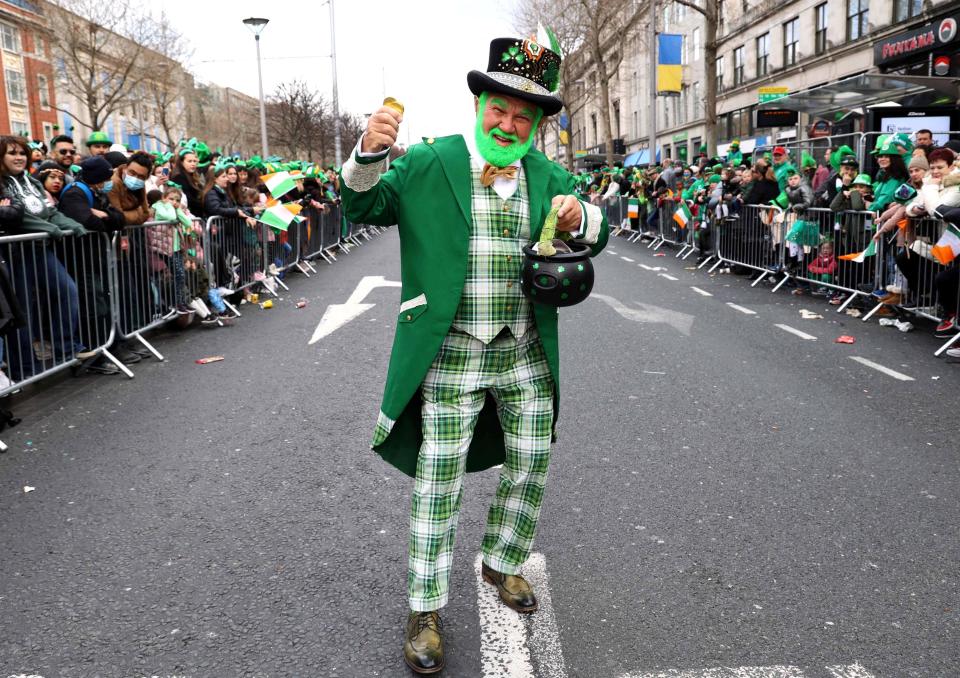Saint Patrick's Day 2023 date, history and parades: When is St. Patrick's Day?
- Oops!Something went wrong.Please try again later.
We know it as an excuse to attend a parade, visit an Irish pub, drink a Guinness or maybe even dye a well-known river green. While not a national holiday in the U.S., St. Patrick's Day is a celebration for Irish and non-Irish Americans alike.
But it is a national holiday in Ireland, and its festivals and events traditionally kick off tourism season. Until about 40 years ago, St. Paddy's Day celebrations were actually solemn and religious. Bars even remained closed. It was American celebration that created the St. Patrick's Day we know today.
For St. Patrick's Day 2023, parades and festivities across the country are planned for this weekend – from Chicago to Dallas.
Why leprechauns and shamrocks? Myth, truth behind St. Patrick's Day celebrations
Reviewed: The 45+ best St. Patrick's Day 2023 sales you can shop right now

When is St. Patrick’s Day?
St. Patrick’s Day, also known as the feast day of the patron saint of Ireland, is on March 17 every year. In 2023, March 17 is a Friday.
St. Patrick's Day parades planned in Chicago, Dallas and more
The Chicago St. Patrick's Day Parade is planned for 12:30 p.m. CT on Saturday. Parade-goers can visit the City of Chicago's website for more details on the weekend festivities and parade route. Additional parades, the South Side Irish Parade and Northwest Side Irish Parade, will be held on Sunday.
The Dallas St. Patrick's Day Parade & Festival is also being held on Saturday, kicking off at 11 a.m. CT. Visitors can find more information about the festival and parade's route on the parade's website.
St. Patrick's Day treat: Shamrock Shake lovers, it's your lucky day. The frozen treat is back on McDonald's menu.
Cook a St. Patrick's Day feast: Make Irish soda bread, stew, potatoes colcannon and more
St. Patrick's Day celebrations are being held across the country this weekend – in cities including Las Vegas, Denver, Washington, D.C., New Orleans and more. Additional festivities will be held on St. Patrick's Day later this week, including New York City's St. Patrick's Day Parade on Friday.
Who was Saint Patrick?
Saint Patrick wasn’t even Irish – he was born in Britain near the end of the fourth century and was taken prisoner by Irish raiders when he was 16. He spent six years in captivity in Ireland, History.com reports, where he eventually became a devout Christian.
According to Patrick’s writing, he believed God’s voice spoke to him in a dream and told him to leave Ireland – and he escaped. Later in another dream, he wrote an angel told him to return to Ireland as a missionary, and he became a priest after a 15-year period of study.
While many believe Patrick was responsible for bringing Christianity to Ireland, History.com reports his mission was to minister to existing Irish Christians as well as convert non-Christians.
Planning a trip to Ireland for March? Ireland made it easier to visit the Emerald Isle
Patrick became a significant feature in Ireland because he chose to incorporate traditional Irish culture and ritual into his practice, like merging the sun (an existing Irish symbol) with the traditional cross to create the famed Celtic cross.
Why do we celebrate St. Patrick’s Day? History of the holiday
Ireland and neighbors across the pond have been commemorating Saint Patrick since the ninth or 10th century, according to History.com.
Saint Patrick was never canonized by the Catholic Church and remains a saint through longstanding historical popularity. Saint Patrick died on March 17, 460, which later became the day we celebrate him and the Irish.
America’s first St. Patrick’s Day celebration was in 1600 in the Spanish colony of present-day St. Augustine, Florida. Spanish colonial records mentioned a celebration for Saint Patrick in 1600 and the first known St. Patrick’s Day parade on March 17, 1601.
The tale of Saint Patrick likely traveled from Ireland to the Americas in the 16th century by way of Richard Arthur, a priest in St. Augustine and an Irish soldier, The Washington Post reported. Records of St. Patrick celebrations died with Arthur, but additional records show Irish soldiers in the English military marched in celebration of Saint Patrick in Boston in 1737 and New York City in 1762.
'Paddy's' or 'Patty's': What is the correct abbreviation for St. Patrick's Day?
Decades of growing Irish patriotism resulted in Irish Aid societies and annual parades of bagpipes and drums until they united to form one official New York City St. Patrick’s Day Parade in 1848, History.com writes.
While rowdy celebrations occurred in the U.S., Irish laws mandated pubs be closed on St. Patrick's Day until the 1970s, and in 1995 the Irish government began campaigning for bigger March 17 celebrations to drive tourism.
Patrick's legacy continued in the U.S., particularly in areas with large groups of Irish immigrants. St. Patrick's Cathedral in New York City is one of the most recognizable churches in the country, and was "created to affirm the ascendance of religious freedom and tolerance," according to the Cathedral's site.
Contributing: Wyatte Grantham-Philips, USA TODAY.
This article originally appeared on USA TODAY: When is Saint Patrick's Day 2023? Parades planned for Chicago, Dallas

